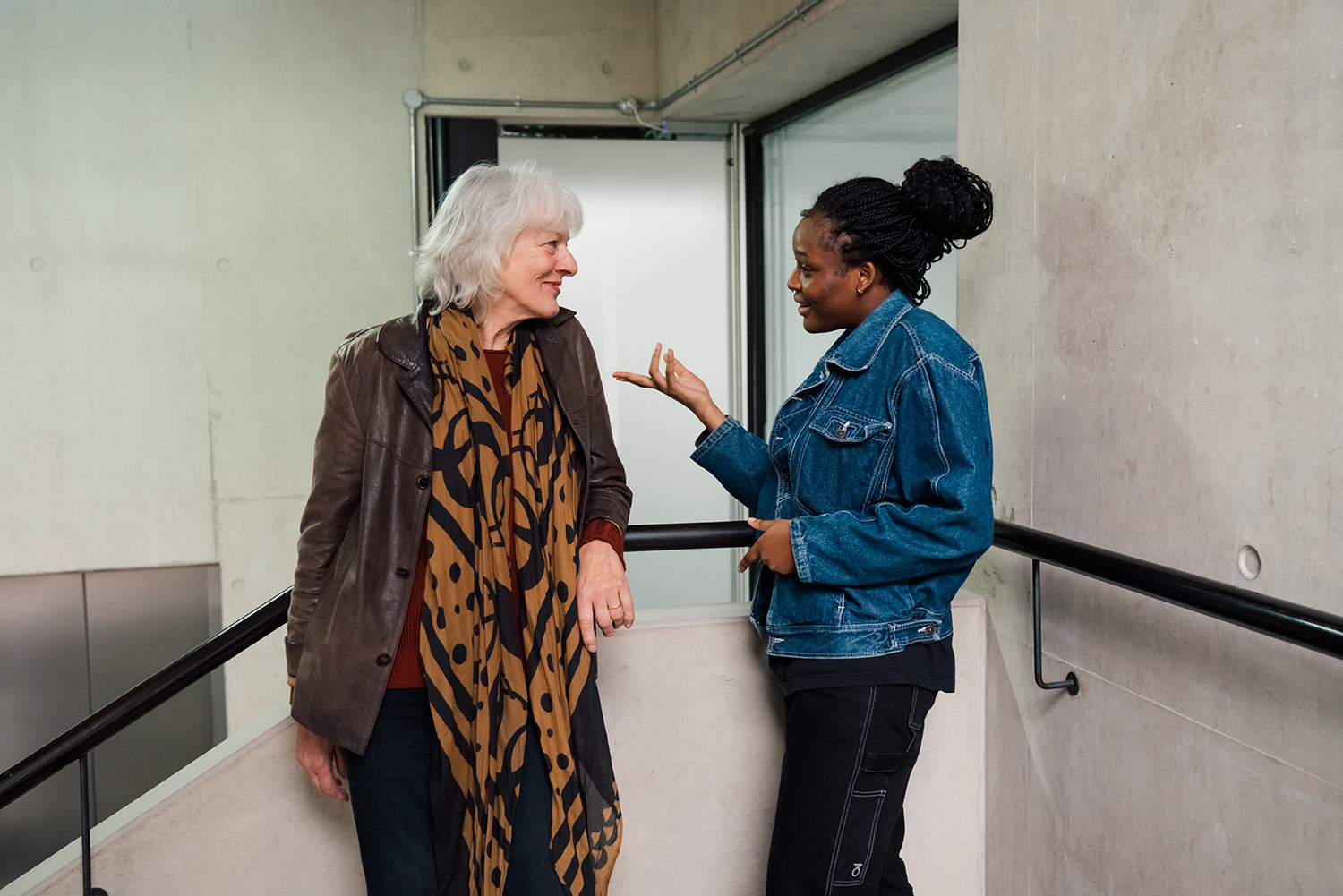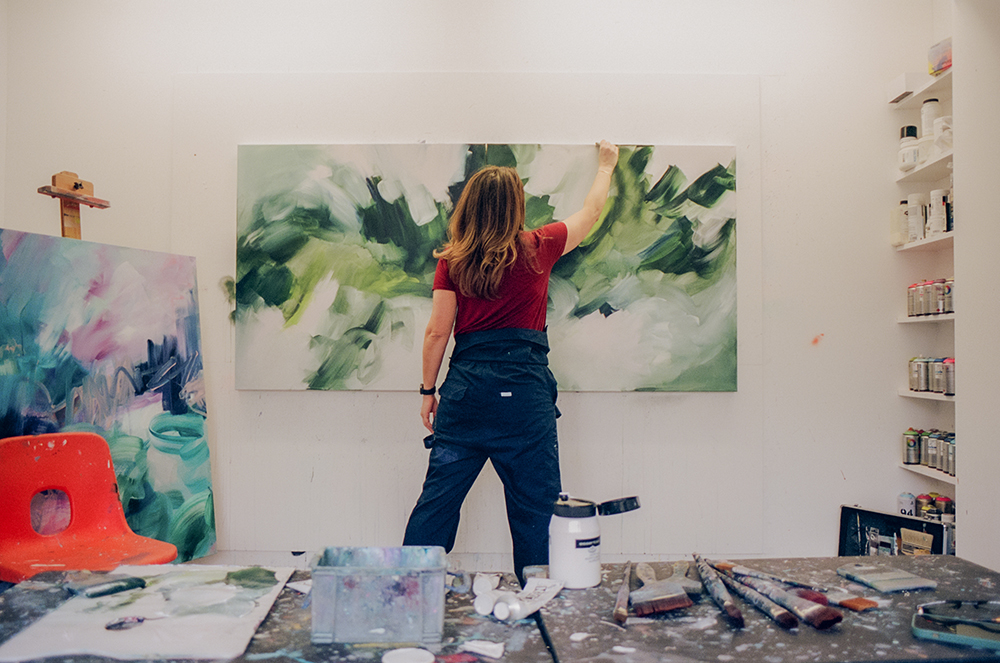
10 minute read
Breaking the mould - A conversation between Aisha Seriki and Almuth Tebbenhoff
by artiqannual
Today’s hyper-digitised society has trained us to search the internet for answers to everything. Who hasn’t downloaded Duolingo in an attempt to learn [enter desired language here]; Interested in learning how to code? There are brilliant tutorials on Youtube for that.
But much of the learning and perspective needed to succeed long-term in any career is rarely found in data on the internet but through conversations and personal relationships with people in and around the workplace. Being an artist can be a solitary profession, and with the isolating experience of the pandemic still lingering in the rearview mirror, we wanted to create an opportunity for a face-to-face conversation with a peer.
Advertisement
Almuth Tebbenhoff is a sculptor inspired by process. She aims to uncover the structure and nature of known materials, such as clay, steel and marble. Through destruction and alteration, she offers a reflection on the human condition and encourages the viewer to challenge ideas of the known.
Inspired by both imagination and experience, Aisha Seriki uses photography to portray women in a light they have been kept out of for too long. Centred around global social issues, her work addresses blackness, gender, migration, class and the many points of intersection within all four.
We invited these two inspiring artists, who embarked on their creative journeys nearly five decades apart, to explore the differences and similarities in their experiences of working as artists and breaking the moulds of society’s preconceived expectations.

Sculptor Almuth Tebbenhoff
Almuth - I want to start with a question for you, Aisha. Since you decided to become an artist, how much support have you felt? Have you had support from your family, friends, teachers - all of that?
Aisha - This is mainly a solo venture sort of thing for me. My parents know I take photos, but I don't speak to them much about what I do. I show them my work sometimes, and they think it's cool, but I don't think they understand. As long as I can make some money from it, that's enough for them. I get more support from my younger sister; she does fashion, so she understands the creative aspect of it. In school I was taught about amazing artists but most of them were all old, so it wasn't relatable and didn't feel like something someone my age could do. Speaking to teachers about being interested in arts, they just said well that's nice but never told me it was something you could pursue as a career. It wasn’t until I attended ‘Develop’ at The Photographers Gallery, a programme for people between 14 to 24 interested in photography. They shared stories and advice from within the photography industry, and it was only then that I thought “oh you can actually do this as a career.” How about you?
Almuth - I grew up on a remote farm in Germany where there was no art whatsoever, but I was lucky to have a rich aunt who had heard about Documenta, an arts festival in Kassel. We lived in a cultural desert, but she was rich and could indulge in these things. She said I'm taking the kids and you can come along if you want. I was 14 years old and, for the first time, experiencing art that had no other function than being exciting to look at and taking your mind somewhere else; it blew my mind! My aunt was laughing, calling the artists 'lunatics' because they were painting messy, smudgy paintings that didn't look like anything at all. Little did she know I was thinking this is what I'm going to do. Have you experienced that? Was there a particular work of art that blew your socks off and made you think oh my god, what if I could do that?

Photographer Aisha Seriki
Aisha - I discovered Barbara Kreuger's and Cindy Sherman's work in my late teens. I always liked theatrics and beautiful imagery, so when I saw Cindy's work, it made sense to me; it felt doable. But I want to know what happened after you went to Documenta. How did you go from there?
Almuth - In those days, art was made by men, especially sculpture. There were female artists, but it required so much of them in addition to their talent, like extraordinary beauty or power, to propel them into an arena where they would still only mildly be taken seriously. I experienced it too for a long time, the feeling of being marginalised. Not until reaching my sixties did I feel I had finally gotten somewhere. That's a real danger because you almost stop taking yourself seriously.
Aisha - How did you keep going despite feeling sidelined; that no one was taking your work seriously?
Almuth - You can't give yourself an alternative. We have to be flexible, especially in times like these when everything feels up in the air. Be flexible, but don't stop being your glorious human self. Make art with love because people will always respond to that. But this is something already shining through in your work! I have seen the photographs where you celebrate your friends, which are so generous and beautiful. How did that come about?
Aisha - I was tired of never seeing myself in the world. I know the feeling when you finally doit's transformative and gives you the permission to dream and expand your imagination of what is possible. I am making work for the younger me, for that person that never saw themselves in the world, and because our society rarely celebrates it. Things are getting better, even though it feels a bit superficial sometimes. A lot of places are saying I'm gonna platform these people, but they are just chucking money around randomly; that's not real. That's also why it was always difficult to envision myself ever working as an artist. There weren't that many female artists to look up to, and even fewer black artists on top of that. At my age now there is a growing community of black female artists in London. For example, with Latoya [Okuneye], who I was recently in an exhibition with at Brookfield Properties, there's a sort of bond there, like I see you, you see me. We need to allow for different voices so it’s not always the same narrative. Everyone's so different and has so many different experiences that they should be able to bring into spaces. We are constantly being put in a box of what we can or can't do, so allowing for those differences and offering support to each other is so important. How were things when you started out? Did you meet someone working as a sculptor that made it feel like a realistic dream?
Almuth - Not really, because they were all guys. It wasn't helpful when it was a famous artist saying I'll help you, you're so talented but then he tries to stick his tongue down your throat, which ruins everything because then it is not about what you want, but what he wants. However, seeing the work of Louise Bourgeois and Dorothea Tanning was extraordinary. The way their work is both playful and psychologically quite disturbing; to see that in big museum shows and in the market space encouraged me not to become a cardboard cut-out of a woman artist. I do remember a particular time seeing a woman at a pottery shop. She sat at the wheel; it was spinning, it was messy, it was fabulous, and I instantly felt drawn to it. Today, the core of my creativity is still clay; getting my hands dirty, and squeezing it into new form. What about you and photography? How did that start?

Our Lives - Perception, Experience, Celebration, an exhibition featuring work by Aisha Seriki and Latoya Okuneye. Located at 30 Fenchurch Street, it was curated in partnership between Brookfield Properties and Artiq.
Aisha - My dad has been obsessed with taking photos for as long as I can remember. Because there were always cameras in our house, I was already comfortable with it, making it feel more accessible. Also, I was way too impatient to draw or paint. But with photography, it was accessible and quick - I could quickly tell a story and quickly share a message. I have always wanted to communicate ideas to people, and it made sense to use photography as the medium for that.
Almuth - You say your family supports you but doesn't fully understand the particularities of what you do. Do you have a community of other creatives around you to ask for advice or be inspired and supported by?

From Aisha Seriki's series Ungrads.
Aisha - I had more of a community a few years ago, but the pandemic really affected that. You meet so many people while studying at university, but as soon as I started working full-time, it became much more isolated. That's why I decided to do a master's. I was worried that if I didn't take the jump and believed in myself, I might get stuck. Being here [Royal College of Arts] has been really good; there's a lot of support here from other students in that regard.
Almuth - I know the feeling. I have been lucky to have this wonderful studio for a long time, but it meant I've always worked alone, and for a while, I got a bit pot-bound. A few years ago, I got a scholarship to work in Italy in a large studio with a bunch of artists - we were eating together, cycling around together, working side by side. It made me appreciate just how important it is for us to be around other artists. When we spend too much time alone, the ego can get a bit out of sync. We see it in the world, both in and out of the art world; people who lose touch with reality. Whereas if you are working side by side with colleagues doing the same thing but differently, that is really to be encouraged. And that basic friendship is crucial, for our development, for our sanity and for good art.

Almuth at Studio Sem, a studio collaborating with sculptors from around the world to produce work in marble and granite.
Photo courtesy of Studio Sem Archives.
Aisha - Yeah, just having the space to bounce your ideas around.
Almuth - Exactly! There are spaces where you can do that, but maybe I'd rather ring you up, Aisha, and say I have this new idea; I need completely fresh eyes on it - come over and have a look!
Aisha - I'd be so down for that, and you are not far from here?
Almuth - No, I'm quite close by. And I make a good coffee as well.










